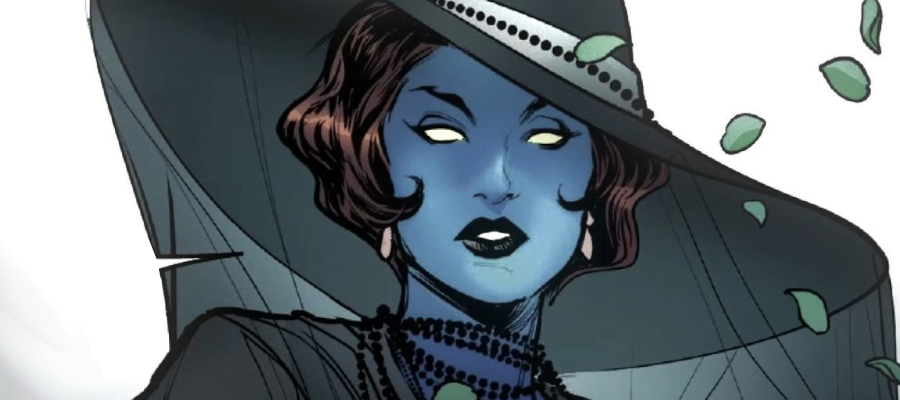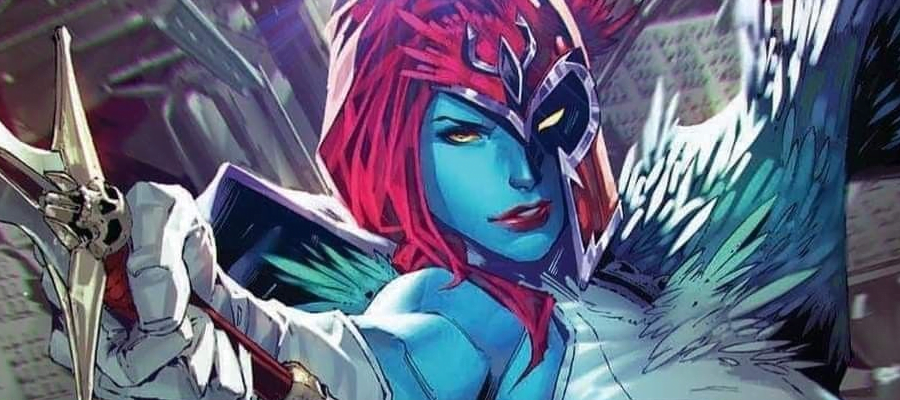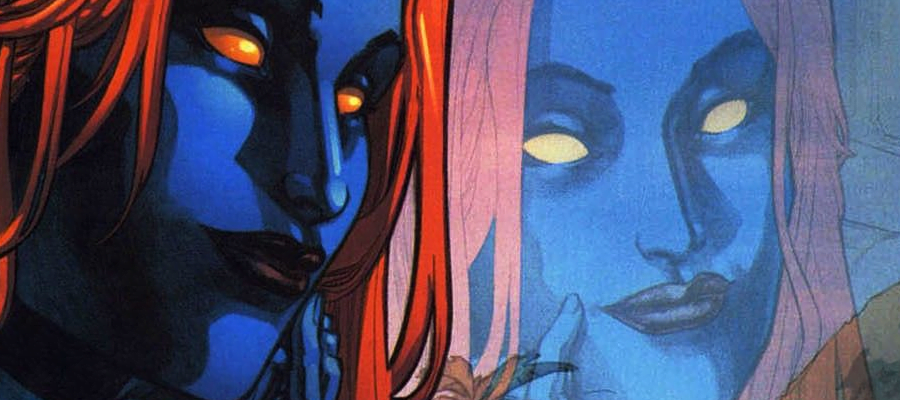In How To Be we’re going to look at a variety of characters from Not D&D and conceptualise how you might go about making a version of that character in the form of D&D that matters on this blog, D&D 4th Edition. Our guidelines are as follows:
- This is going to be a brief rundown of ways to make a character that ‘feels’ like the source character
- This isn’t meant to be comprehensive or authoritative but as a creative exercise
- While not every character can work immediately out of the box, the aim is to make sure they have a character ‘feel’ as soon as possible
- The character has to have the ‘feeling’ of the character by at least midway through Heroic
When building characters in 4th Edition it’s worth remembering that there are a lot of different ways to do the same basic thing. This isn’t going to be comprehensive, or even particularly fleshed out, and instead give you some places to start when you want to make something.
Another thing to remember is that 4e characters tend to be more about collected interactions of groups of things – it’s not that you get a build with specific rules about what you have to take, and when, and why, like you’re lockpicking your way through a design in the hopes of getting an overlap eventually. Character building is about packages, not programs, and we’ll talk about some packages and reference them going forwards.
Let’s look at the first* transgender* X-Men*!
Unravelling The Mystique
Mystique is a character who first appeared in comic books back in the ye olden times of the nineteen hundred and seventies and if you’re familiar with how characters in comics morph over time (hah) you may be surprised to learn that broadly speaking she’s been pretty consistent throughout that entire period. In simplest terms, Mystique is ‘a person’ who can shapeshift to change her appearance. In some stretches of comics, she has the capacity to use this to create what you might consider ‘gross physical qualities’ like sprouting wings to fly with or growing claws to fight with, armoured skin, or in some really batty-seeming ideas, making herself completely flat so she can float on air currents. When you ask anyone about that, the usual response to that list goes something like ‘oh okay, okay, okay, what, no, that last one is dumb,’ and I’m inclined to agree.
What this means is that Mystique is defined first and foremost by being a kind of human with the ability to change shape, and not in too wild a way. Maybe you can integrate the monstery traits (and I love me some monstery traits!) but this is a character who is meant to operate within normal parameters like gunfights and assassinations and using her shapeshifting to get to places where that dangerous element of who she is best applied.
I would imagine then, that Mystique is probably some variety of Martial character class, almost always not a character who wants to be the center of attention, and maybe some monsterism gets involved. She can disguise herself freely, so what armour or gear she’s wearing is probably something you can integrate into all kinds of looks.
Oh, and most obviously she is a constantly self-disguising character who can always take on new forms every few moments.
What hits all these notes?
Glossary Note: Conventionally, the term used in D&D for this mechanical package is race. This is the typical term, and in most conversations about this game system, the term you’re going to wind up using is race. For backwards compatibility and searchability, I am including this passage here. The term I use for this player option is heritage.
A Face For All Builds
Make a changeling.
That’s it. Literally, that’s it.
The nature of what Mystique is is one where she taps into a vein of narrative space that I think was so well-worn, so clearly understood, it, and things like the D&D doppleganger and their babby player-accessible form the changeling are all operating in that same space.
Of course, you might not be able to play a changeling. You might have a DM who has firm views on things like dopplegangers and disguise magic, and the way they can erode the basic level of player trust with the game they’re interacting with. They may not allow the changeling, for reasons of it being dangerous or overpowered or specifically tied to the lore of Eberron. These are all things a DM may choose to do and reasons they may choose to do them, though I can’t imagine bothering in this case.
In that case, your Mystique-a-like needs to pick up the feat Ritual Caster and the ritual Change Self. You’ll also want training in the Arcana skill (to be convincing in your disguise) or take the feat Deception Mastery, to translate that Change Self skill over to Bluff. If this is the route you want to pursue you can take the Cult Escapee background, and add both Bluff and Arcana to your class skill lists, and get a +1 to both, which means you’ll have every reason to be good at them. This also means that your Mystique-a-like will have a lot of obscure knowledge and be able to fake having obscure knowledge she doesn’t have right now. With this mash up together, you’ll have a heroic tier character, of any heritage, who can lie and cheat and change shape every minute multiple times a day, depending on their healing surge availability.
You do need another Deception ritual to take Deception Mastery though, and of that list you need to pick something that doesn’t violate the idea of Mystique’s powers being about altering herself and her body, and not about like, imposing things in the mind of strangers. The best Deception ritual for this, then, as something that can feel like it’s just an application of a skill on a magical level is Calm Emotions. This puts the budget for these two effects at 535 gold pieces, and two feats. If you go this route, you need a character who doesn’t have any high demand first or second level feats.
This compares to getting a Hat Of Disguise. If your game starts at level 10, you can have the Hat of Disguise just automatically, which does violate this article series’ general attitude towards making a character function in Heroic. For 5,000 gp, you can use Change Self. At Will. Without costing any healing surges, as a standard action.
And all of this is to get access to an effect that has zero combat impact. None of the effects described are good in combat, and Calm Emotions is specifically not useful in combat. The effect is available by level 2 for a character who is making low-impact choices and spending modest currency, or available at level 10 with a minor up-front investment that lets you do it forever, freely and easily thereafter. What I’m getting at with all these examples is that if for some reason your DM is against the Changelings in their game for balance reasons or wordbuilding reasons or free access to this effect reasons, you need to talk to them about these ways that this effect is already available in a variety of different ways and make sure they understand, with comparison, how getting a hat of disguise earlier and worse isn’t that big a deal. If they don’t want this effect at all in their game world, that’s valid and good but also you should know that ahead of time if you were interested in making a Mystique and then don’t try and make a Mystique in the context of a game that doesn’t want her, because trying to get rid of this effect by cutting off a mid-level heritage option just pushes the player to modestly more inconvenient but not difficult options.
But really, just build a Changeling.
The Most Obvious Option
You need a character that’s feat-light in its demands, avoids the centre of attention, and can strike very hard from advantageous position? Well, that sounds like a Rogue. Yes, the Rogue, the all purpose martial striker, the sadly second best starter kit character, Rogues have all the skills required to pull of the Mystique-like skillset and they get trained in so much. Changeling Rogue is so simple a solution to this question it was honestly why I didn’t start on this article for so long. Like this is obvious, right?
But Now With More Monster
Hang on though, you might say, what if I want to play a Mystique with those claws and wings and natural armour? What if I want to play a Bond Girl whose backup plan is turning into The Hulk? Well, for that end, I recommend we look to the ranger as a class option, and the Pack Outcast as a theme option. Hang on, Pack Outcast? Why not a werebeast? Wellll you may have heard me comment on this recently, but Werebear and Werewolf only really work with very specific power combinations and crucially, all the martial strikers that care about basic attacks care about weapon basic attacks, which the werewolf and werebear don’t make.
But if you want to shapeshift into a form that’s identifiably not human as you fight, the Pack Outcast gives you that; you can claim it’s any old horrible looking form (or I dunno, disturbingly sexy wolf furry if you want?) while the theme still provides you with a solid combat addition that doesn’t work against something like the Ranger.
Rangers go where they want, they fight in melee and at range, you could wield hand crossbows if that’s your jam. The basic skeleton of the Ranger is very good at ‘hit things’ and ‘go places’ so you should be right here.
Off The Wall
Trying as hard as I can to concoct something that works with Mystique’s whole vibe and doesn’t involve adding really fruity powers to her I find myself arriving at a build as basic as a Fighter. There’s definitely a way, in my mind, for Mystique to use her shapeshifting and combat ability to become the centre of attention and force people to engage with her, and that could be combined with things like grabs (with extra sticky hands!). Plus, Fighters have a lot of healing surges, which can be good for Change Self.
Junk Drawer
I dunno, the druid? It’s rare I finish one of these without any alternative ideas, but I think it’s because the people making the game already made something perfect for this character to work with.
This was an interesting and challenging article to make mostly because the actual build is really easy and obvious. Once you settle on the Changeling (or its jailbroken version), you have to just dig through the things that definitely don’t work. You might decide you want a Mystique who is a wizard or a psion or something else and that opens up options.
Think of it like a platform to build off. Mystique’s abilities are things that can be done easily and readily in the game, and all you need to do is introduce them. Check with your DM about it, and crucially, make sure they know the kinds of things you want to do with her. You want to infiltrate and sneak around, and you don’t want that to be useless and you don’t want it to be something other factions can do so easily it becomes boring.
So talk to your DM.



